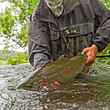As a child, I was painfully shy. As an adult I’m painfully shore shy. There’s a big difference. I talked to no one when I was little. Now I talk to everyone, but ask me to cast toward the bank and I’m shy. My fly-casting arm becomes ramrod stiff. The willows of western water eat more of my flies than fish do. It’s true. I hang a lot of money on bank branches.
Sure I can place the fly right where you want me to, tucked up neatly under the overhang with my lefty swing. A big brown is sure to be there. I will even target the honey hole perfectly for several casts in a row, but then my roll runs out and I’m snagged. Happens every time I try to fight my freshwater shore shyness.
Now saltwater on the other hand, proves friendlier than what my Idaho instincts know. Mangroves are not willows. Mangroves don’t want my fly and easily give it up, unlike the willows that hold hostage a fat wallet’s worth of my flies. Mangroves are hardwood, but it seems hooks don’t gain permanent set in their rubbery-textured outer layer.
The easy give of mangroves matters even more beyond freeing fisherman’s flies. Mangroves matter in the saltwater world. The ocean’s canopy is home to thousands of wild animals: residents and migrators. Mangroves also keep the liquid where it is and the land where it should be. Ripping mangrove roots out of the water wreaks havoc on the health of a natural system.
“Mangroves themselves are a keystone species. A wide variety and amount of wildlife, including fish, rely on mangroves for their livelihood and survival,” says Adam Sauerland, J.N. Ding Darling National Wildlife Refuge concessionaire assistant manager and naturalist. “Seventy-five percent of Florida sport fish and 90 percent of commercial fish rely on mangroves as home and safe haven especially for juveniles.”
Red Mangroves
Reds are considered the outskirts. That’s what most people see along the water’s edge. Reds have top-drop roots and prop-base roots. The root system is extremely efficient and best suited to combat wave and wind energy. Reds take wear and tear of the elements best.
Black Mangroves
Black mangroves are the next layer in. They have a unique way of overcoming the salty environment most other aquatic plants can’t swallow. Blacks have a straw system of roots shooting straight up from the bottom. Those straws suck in salt then pump it out through leaves. Black mangrove roots sometimes show in low tide.
White Mangroves
White mangroves are the internal zone within in the red and black. They are the least tolerant of salt. Whites are visually similar to reds, but have rounded, oval leaves where reds and blacks have longer, elliptical leaves that come to a point.

Awareness of such a valuable, yet fragile, ecosystem is rising. A recent construction project in Cancun taking a slap for slaughtering a mangrove swamp in January is proof of that.
According to Associated Press, the real estate development, Tajamar, is now blocked by court order for not preserving wetlands, but only after about 120 mangrove acres bent to bulldozers and a coalition of 10 Mexican environmental groups pushed back.
“This is excellent news, that the Mexican court system has recognized the environment as a right that supersedes private interests,” says the coalition.
As anglers, the mangroves we see on the edges of the waterways we fish are only the external case of the canopy. We cast flies beneath red mangroves for tarpon and bones. Within that visible perimeter are black mangroves. And even deeper, where I’m sure the biggest birds and fish smile in serene safety, are white mangroves.

“Mangroves are really holding this entire island together,” says Sauerland who works on Florida’s Sanibel Island. “They’re erosion control and hurricane buffers. If you have a healthy mangrove ecosystem, you’re going to have a healthy economy and a healthy livelihood.”
Mangroves hold a multitude of purpose and I appreciate that purpose. Especially when the mangroves I’m casting at easily free my fly so the fish can find it.
































Comments